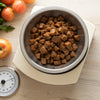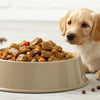Does Wet Food Make Dogs Fat? Exploring the Relationship Between Canine Diet and Weight Management
- Houndsy
Table of Contents
- Introduction
- Understanding Wet Dog Food
- The Impact of Wet Dog Food on Weight Gain
- Benefits of Wet Dog Food
- Potential Downsides of Wet Dog Food
- Mixing Wet and Dry Dog Food
- Case Studies
- Conclusion
- FAQs
Introduction
As devoted pet parents, we all want our furry friends to lead happy, healthy lives. Recent statistics reveal that around 56% of dogs in the United States are considered overweight or obese, which can lead to serious health issues and shortened lifespans. This alarming number raises a crucial question: does wet food make dogs fat?
In this comprehensive blog post, we’ll delve into the implications of wet dog food on canine weight by examining its nutritional values, palatability, and digestibility. We’ll also highlight the benefits and potential drawbacks of incorporating wet food into your dog's diet, providing insights on achieving the right balance for optimal health. By the end of this article, you’ll possess a well-rounded understanding of how wet dog food fits into the broader framework of pet nutrition and weight management.
So, let's embark on this enlightening exploration together to better understand the nuanced effects of wet food on our beloved dogs' waistlines!
Understanding Wet Dog Food
What is Wet Dog Food?
Wet dog food, also known as canned or moist food, is a popular choice for many pet owners. Its primary components typically include meat, vegetables, and broth, culminating in a soft and aromatic option for dogs. The higher moisture content—often ranging from 70% to 80%—makes it a favorite among pets. This hydration factor becomes vital as it encourages dogs to consume more fluids, which is particularly beneficial for those who may not drink enough water daily.
Nutritional Composition
When considering wet dog food's potential to contribute to weight gain, it is essential to evaluate its nutritional composition. Wet dog food typically contains:
- Higher Moisture Content: Not only does this aid in hydration, but it also adds volume without contributing additional calories.
- Protein: Wet foods often feature substantial protein levels, which support muscle maintenance and overall health.
- Fat Content: The fat percentage varies significantly among different brands and types, directly impacting caloric density.
- Carbohydrates: Some varieties include grains or fillers, which can affect weight management if not correctly balanced.
As pet owners, we must scrutinize wet food options, as exercise caution in choosing varieties that emphasize high-quality ingredients over fillers.
The Impact of Wet Dog Food on Weight Gain
Does Wet Dog Food Cause Weight Gain?
The direct answer is that wet food can contribute to weight gain, but it doesn't inherently cause it. The key determinants of whether your dog gains weight include:
-
Caloric Intake: Any food can lead to weight gain if caloric intake exceeds a dog's daily energy expenditure. Hence, both wet and dry foods must be portioned correctly.
-
Quality of Ingredients: Nutrient-rich wet foods that prioritize high-quality protein and fiber will generally support healthier weight management compared to those that are rich in fillers and low-grade components.
-
Portion Control: Just like humans, dogs may overeat. If we do not manage portions effectively, even low-calorie wet foods could lead to unwanted weight gain.
Palatability and Overeating
Wet dog food tends to be more palatable due to its aroma and flavor, which can lead to increased food intake. If we observe our dogs being overly eager for their meals, it can be tempting to feed them more than the recommended amount. This behavior can inadvertently lead to weight gain, making moderation and portion control imperative.
Nutritional Balance
When transitioning from dry to wet food, it is crucial to maintain an overall balance within your dog’s dietary regimen. Mixing wet and dry foods often yields positive results by ensuring a well-rounded meal. The Houndsy Kibble Dispenser provides a solution for precise portion control, making it easier to measure appropriate quantities and minimizing the guesswork associated with feeding. At Houndsy, we aim to help you ensure that your dog receives the right amount of food every time—no more, no less!
Benefits of Wet Dog Food
Increased Hydration
A leading advantage of wet dog food is its high moisture content. Proper hydration is crucial for our pets' health, especially for aging dogs or those with a lower interest in drinking water. Increasing overall water intake through wet food can promote kidney function and urinary health.
Easier to Chew
Wet food is an excellent option for puppies and senior dogs, as well as those with dental issues. Its soft texture makes it easier to chew and digest, providing comfort for dogs recovering from surgery or struggling with sensitive stomachs.
Enhanced Nutritional Value
Many wet foods are formulated with high-quality ingredients, offering a more balanced source of nutrition. Picky eaters may also benefit from wet food, as its sensory appeal often encourages them to consume a nutritionally complete diet.
Potential Downsides of Wet Dog Food
Cost Considerations
One downside to wet dog food is its higher price compared to dry kibble. Pet parents with budget limitations might find it necessary to balance their dog's diet with high-quality dry food to maintain nutritional standards without overspending.
Spoilage and Storage
Wet food tends to spoil quickly once opened. Proper storage practices are needed to keep it fresh and safe for your dog. This increased chance of spoilage can lead to waste and an uptick in feeding costs if not managed effectively.
Dental Health
While wet food is easier to chew, it may not provide the same dental benefits that dry kibble does, which helps in scraping plaque and tartar off teeth. For dogs primarily consuming wet food, regular dental care—such as teeth brushing and dental chews—becomes essential in preventing dental issues.
Mixing Wet and Dry Dog Food
A Balanced Approach
Many pet parents find that mixing wet and dry dog food is an effective way to leverage the benefits of both types. This approach may help foster a balanced diet while keeping feeding costs manageable.
Maintaining proper portion sizes is crucial, especially when mixing types of food. Utilizing the Houndsy Kibble Dispenser allows for easy measurements, which help you avoid overfeeding while ensuring your dog remains satisfied.
Transitioning Between Foods
If you're contemplating switching your dog to wet food, it's important to transition gradually. A sudden change in their diet could lead to gastrointestinal upset. Start by introducing a small amount of wet food into their regular dry food, progressively increasing the wet food portion over several days.
Case Studies
Case Study 1: A Picky Eater
Let’s meet Bella, a 5-year-old beagle known for her finicky eating habits. Her owner noticed weight loss and low energy levels. After consulting with a veterinarian, Bella’s owner decided to mix wet food into her diet alongside her regular dry food. Within weeks, Bella's weight stabilized, and her energy levels returned to normal. This case illustrates how enhancing flavor and moisture can positively impact the eating habits of picky eaters, ultimately promoting health.
Case Study 2: Senior Dog with Dental Issues
Rex, a 10-year-old Labrador, faced challenges with dental problems that made chewing dry kibble uncomfortable. His owner transitioned him to a wet food diet, which not only made mealtime enjoyable but also contributed to maintaining a healthy weight. Rex's quality of life significantly improved as he was able to eat without discomfort.
Conclusion
In conclusion, wet dog food does not inherently cause weight gain; various other factors, such as caloric intake, ingredient quality, and portion management, come into play. Understanding the nutritional profile and making informed diet choices will allow you to support your furry friend in maintaining a healthy weight and promoting overall well-being.
Throughout this post, we have highlighted how wet food, particularly when mixed with dry food, can add value to your dog's diet. If you are looking to enhance your dog’s feeding experience while retaining proper portion control, we encourage you to explore the Houndsy Kibble Dispenser Order Now. We share a commitment to making the daily feeding ritual more convenient and enjoyable, reinforcing the health of your beloved pet.
FAQs
1. Can I feed my dog only wet food?
Absolutely! Dogs can thrive on a wet food diet, but it’s essential to ensure that it’s nutritionally complete and contains high-quality ingredients.
2. Will wet food make my dog’s teeth worse?
Wet food does not inherently damage dogs' teeth but may not provide the same dental benefits as dry food. Regular dental care is essential for dogs primarily consuming wet food.
3. How can I prevent weight gain from wet food?
Monitor portion sizes and ensure that total caloric intake aligns with your dog's energy needs. Mixing wet and dry food can contribute to a balanced diet.
4. Is wet food more expensive than dry food?
Yes, wet food generally costs more than dry kibble. Balancing both choices helps maintain a budget while providing necessary nutrition.
5. How should I transition my dog to wet food?
Begin by slowly mixing wet food into your dog's regular diet, gradually increasing the wet food portion over the span of a week to avoid digestive issues.













